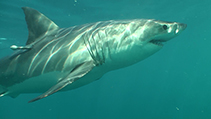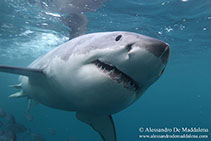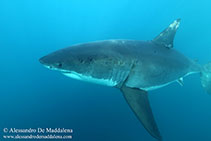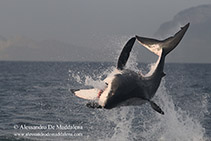Carcharodon carcharias (Linnaeus, 1758)
Great white shark
個人による観察記録の追加 Fish Watcher
| Native range | All suitable habitat | Point map | Year 2050 |

|
| This map was computer-generated and has not yet been reviewed. |
| Carcharodon carcharias AquaMaps Data sources: GBIF OBIS |
United States (contiguous states) country information
Common names:
Great white shark, Great white shark, Man eater
Occurrence: native
Salinity: brackish
Abundance: | Ref:
Importance: | Ref:
Aquaculture: | Ref:
Regulations: protected | Ref: Compagno, L.J.V., 1998
Uses: no uses
Comments: Occurs in Monterey Bay (Ref. 12091). In 1961, strays were recorded from Willapa Harbour (Ref. 6885). California appears to be a particularly vulnerable region for shark attacks, possibly because of the large populations of seals, otters and sea lions that attract the predatory shark to its waters (Ref. 9987). Protected in parts of the United States (Ref. 26346). Also Ref. 13574, 26938.
National Checklist:
Country Information: https://www.cia.gov/library/publications/resources/the-world-factbook/geos/us.html
National Fisheries Authority: http://www.nmfs.gov
Occurrences: Occurrences Point map
Main Ref: Compagno, L.J.V., 1984
National Database:
Occurrence: native
Salinity: brackish
Abundance: | Ref:
Importance: | Ref:
Aquaculture: | Ref:
Regulations: protected | Ref: Compagno, L.J.V., 1998
Uses: no uses
Comments: Occurs in Monterey Bay (Ref. 12091). In 1961, strays were recorded from Willapa Harbour (Ref. 6885). California appears to be a particularly vulnerable region for shark attacks, possibly because of the large populations of seals, otters and sea lions that attract the predatory shark to its waters (Ref. 9987). Protected in parts of the United States (Ref. 26346). Also Ref. 13574, 26938.
National Checklist:
Country Information: https://www.cia.gov/library/publications/resources/the-world-factbook/geos/us.html
National Fisheries Authority: http://www.nmfs.gov
Occurrences: Occurrences Point map
Main Ref: Compagno, L.J.V., 1984
National Database:
Common names from other countries
分類 / Names 共通名の | 類義語 | Catalog of Fishes(部類, 種) | ITIS | CoL | WoRMS | Cloffa
板鰓亜鋼(サメとエイ類) (sharks and rays) > Lamniformes (Mackerel sharks) > Lamnidae (Mackerel sharks or white shark)
Etymology: Carcharodon: carchar-, presumably referring to Carcharias (Odontaspidae); odon (Gr.), tooth, “Teeth as in Carchari[a]s, serrated on both edges” (See ETYFish); carcharias: From the Ancient Greek karkharías, shark, derived from kárkharos, sharp or jagged, referring to its teeth (“dentibus serratus”) (See ETYFish).
More on author: Linnaeus.
Etymology: Carcharodon: carchar-, presumably referring to Carcharias (Odontaspidae); odon (Gr.), tooth, “Teeth as in Carchari[a]s, serrated on both edges” (See ETYFish); carcharias: From the Ancient Greek karkharías, shark, derived from kárkharos, sharp or jagged, referring to its teeth (“dentibus serratus”) (See ETYFish).
More on author: Linnaeus.
Environment: milieu / climate zone / depth range / distribution range 生態学
海; 汽水性の; 海洋回遊性 (Ref. 51243); 深さの範囲 0 - 1280 m (Ref. 106604), usually 0 - 250 m (Ref. 55270). Subtropical; 61°N - 58°S, 180°W - 180°E
分布 国々 | 国連食糧農業機関の区域 | エコシステム | 事件 | Point map | 導入 | Faunafri
Worldwide. Very wide-ranging in most oceans; among the greatest habitat and geographic range of any fish, tolerating temperatures of 5°-25°C.
Length at first maturity / サイズ / 重さ / 年齢
Maturity: Lm 475.0, range 450 - 500 cm
Max length : 640 cm TL オス/雌雄の選別がない; (Ref. 12489); 最大公表体重: 0.00 g; 最大記録サイズ: 36 年 (Ref. 31395)
Max length : 640 cm TL オス/雌雄の選別がない; (Ref. 12489); 最大公表体重: 0.00 g; 最大記録サイズ: 36 年 (Ref. 31395)
簡単な記述 検索表 | 形態学 | 形態計測学
背面の脊椎 (合計) : 0; 肛門の骨: 0. A huge, spindle-shaped shark with conspicuous black eyes, a blunt, conical snout and large, triangular, saw-edged teeth (Ref. 5578). First dorsal-fin origin usually over the pectoral-fin inner margins (Ref. 43278, 6871). Caudal fin crescentic (Ref. 247). Lead-grey to brown or black above, lighter on sides, and abruptly white below (Ref. 6851). Black spot at rear pectoral fin base (Ref. 6851).
Primarily a coastal and offshore inhabitant of continental and insular shelves, but may also occur off oceanic islands far from land (Ref. 247, 43278, 58302). Often close inshore to the surf line and even penetrates shallow bays (Ref. 247). Maximum depth of 700 fathoms (or 1280 m) reported by Bigelow & Schroeder, 1948 is erroneous (Francis et al., 2012 in Ref. 106604). Pelagic, capable of migration across oceanic regions (Ref. 58302). Usually solitary or in pairs but can be found in feeding aggregations of 10 or more; does not form schools (Ref. 247). Feeds on bony fishes, sharks, rays, seals, dolphins and porpoises, sea birds, carrion, squid, octopi and crabs (Ref. 5578) and whales (Ref. 32140). Ovoviviparous, embryos feeding on yolk sac and other ova produced by the mother (Ref. 43278, 50449). Number of young born per litter, 7 (Ref. 31395) to 14 (Ref. 26346). Reported by some experts to attack humans which they mistake for their normal prey (Ref. 47). Most attacks occur in estuaries. Caught by big-game anglers and line boats for its jaws (Ref. 5578). Reported to cause poisoning (Ref. 4690). Flesh is utilized fresh, dried-salted, and smoked for human consumption, the skin for leather, liver for oil, carcass for fishmeal, fins for shark-fin soup, and teeth and jaws for decorations (Ref. 13574). Maximum total length is leading to much speculation and some measurements are found to be doubtful. Possibly to 6.4 m or more in length (Ref. 43278), considered the world's largest predator with a broad prey spectrum. The record of 10.98 m is incorrect (Ref. 13574). Maximum total length for male from Ref. 91029. Sometimes considered the most dangerous shark in the world (Ref. 26938). Maximum depth reported taken from Ref. 86942.
Life cycle and mating behavior 成熟 | 繁殖 | 放精 | 卵 | 生産力 | 幼生
Exhibit ovoviparity (aplacental viviparity), with embryos feeding on other ova produced by the mother (oophagy) after the yolk sac is absorbed (Ref. 50449). Up to 10, possibly 14 young born at 120-150 cm (Ref. 26346). Distinct pairing with embrace (Ref. 205). Male and female may swim in parallel while copulating (Ref. 28042, 49562).
主な参考文献
Upload your references | 参考文献 | コーディネーター : Compagno, Leonard J.V. | 協力者
Compagno, L.J.V., 1984. FAO Species Catalogue. Vol. 4. Sharks of the world. An annotated and illustrated catalogue of shark species known to date. Part 1 - Hexanchiformes to Lamniformes. FAO Fish. Synop. 125(4/1):1-249. Rome, FAO. (Ref. 247)
Human uses
水産業: 少数商業の; ゲームフィッシュ: はい
FAO(水産業: 代謝, 種の外形; publication : search) | FishSource | 私達の周りの海
より多くの情報
Population dynamics
成長のパラメーター
Max. ages / sizes
Length-weight rel.
Length-length rel.
体長組成
Mass conversion
補充
豊度
成長のパラメーター
Max. ages / sizes
Length-weight rel.
Length-length rel.
体長組成
Mass conversion
補充
豊度
Physiology
Body composition
Nutrients
酸素消費
水泳形態
泳ぐ速さ
Visual pigments
Fish sound
Diseases & Parasites
Toxicity (LC50s)
Body composition
Nutrients
酸素消費
水泳形態
泳ぐ速さ
Visual pigments
Fish sound
Diseases & Parasites
Toxicity (LC50s)
用具
Bio-Quiz | E-book | 野外観察図鑑 | 検索表 | Length-frequency wizard | 生活史の基盤ツール | 目的のマップ | Classification Tree
| Catch-MSY |
特記事項
XMLをダウンロードして下さい
インターネットの情報源
Aquatic Commons | BHL | Cloffa | BOLDSystems | Websites from users | Check FishWatcher | CISTI | Catalog of Fishes(部類, 種) | DiscoverLife | DORIS | ECOTOX | Faunafri | Fishtrace | GenBank(ゲノム, ヌクレオチド) | GloBI | GOBASE | | Google Books | Google Scholar | Google | IGFA World Record | MitoFish | 国のデーターベース | Otolith Atlas of Taiwan Fishes | PubMed | Reef Life Survey | Scirus | SeaLifeBase | 生命の木 | Wikipedia(行く, 検索する) | World Records Freshwater Fishing | 動物に関する記録
Estimates based on models
Preferred temperature (Ref. 115969): 11.3 - 24.9, mean 18.1 (based on 4368 cells).
Phylogenetic diversity index (Ref. 82804): PD50 = 1.0313 [Uniqueness, from 0.5 = low to 2.0 = high].
Bayesian length-weight: a=0.00871 (0.00625 - 0.01214), b=3.05 (2.96 - 3.14), in cm Total Length, based on LWR estimates for this species (Ref. 93245).
栄養段階 (Ref. 69278): 4.5 ±0.4 se; based on diet studies.
回復力 (Ref. 120179): 非常に低い, 14年以上の倍増期間の最小個体群 (K=0.06; tm=8-12; tmax=36; Fec=7).
Fishing Vulnerability (Ref. 59153): Very high vulnerability (86 of 100).
Climate Vulnerability (Ref. 125649): High vulnerability (60 of 100).







